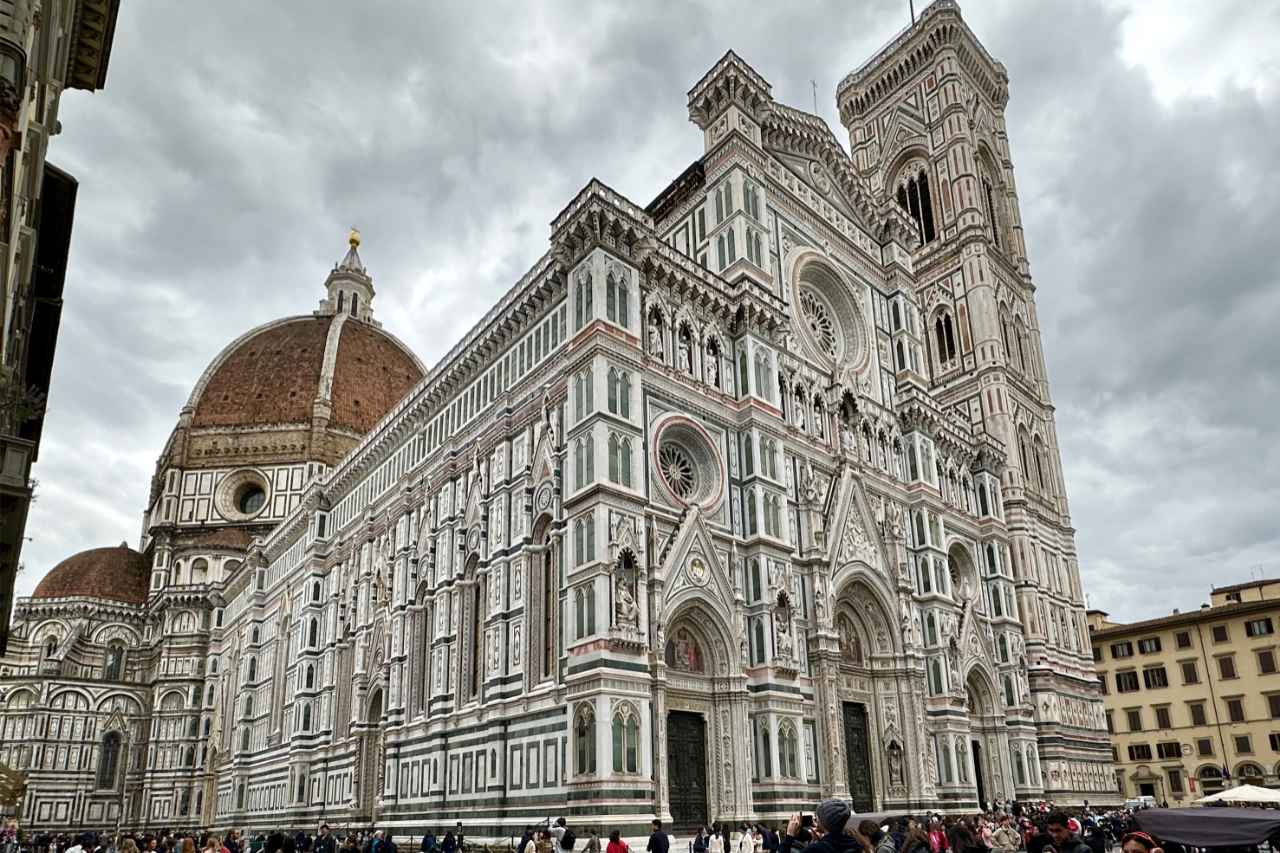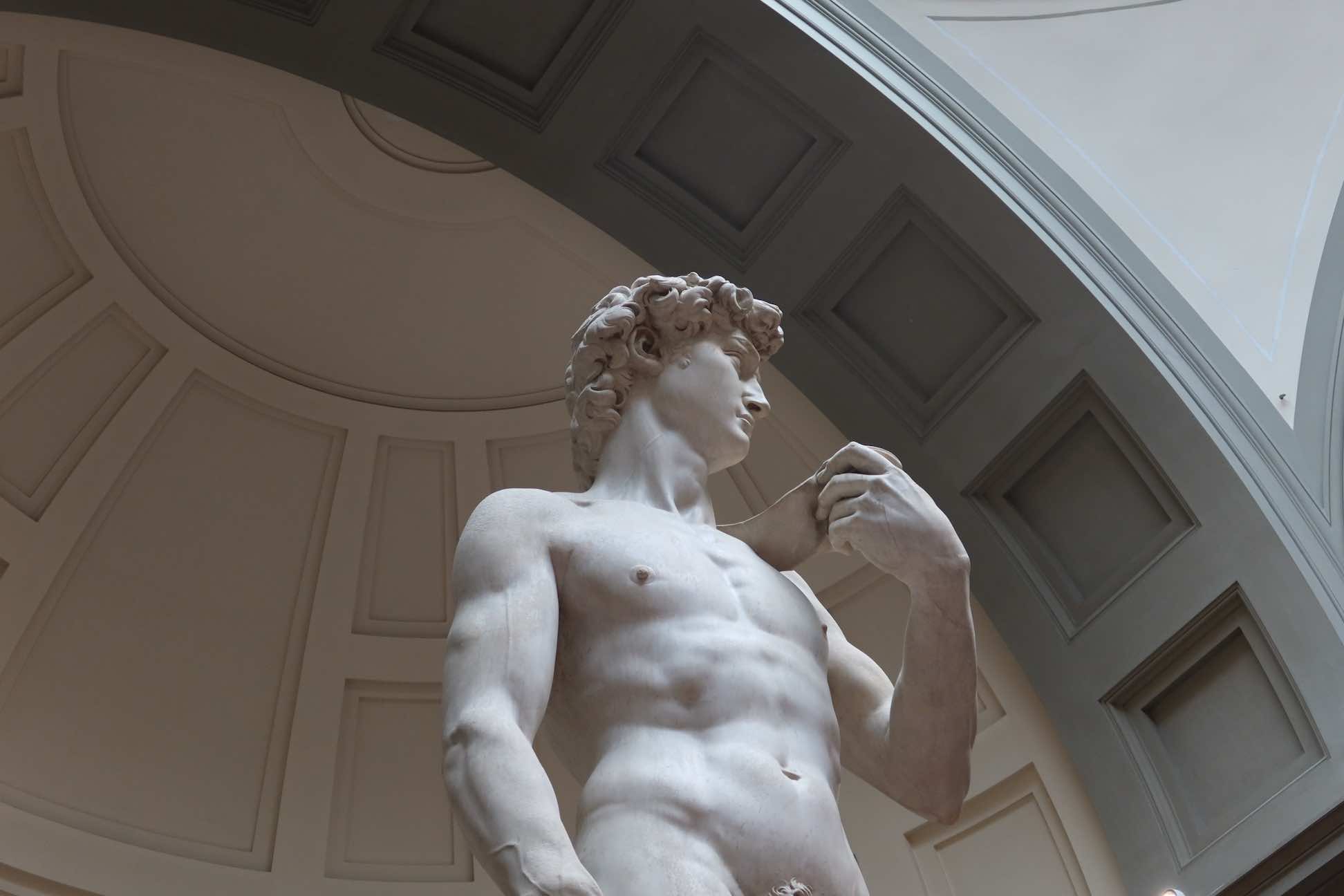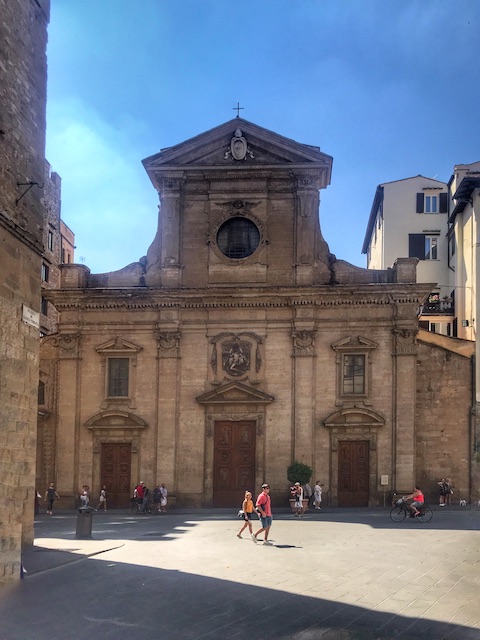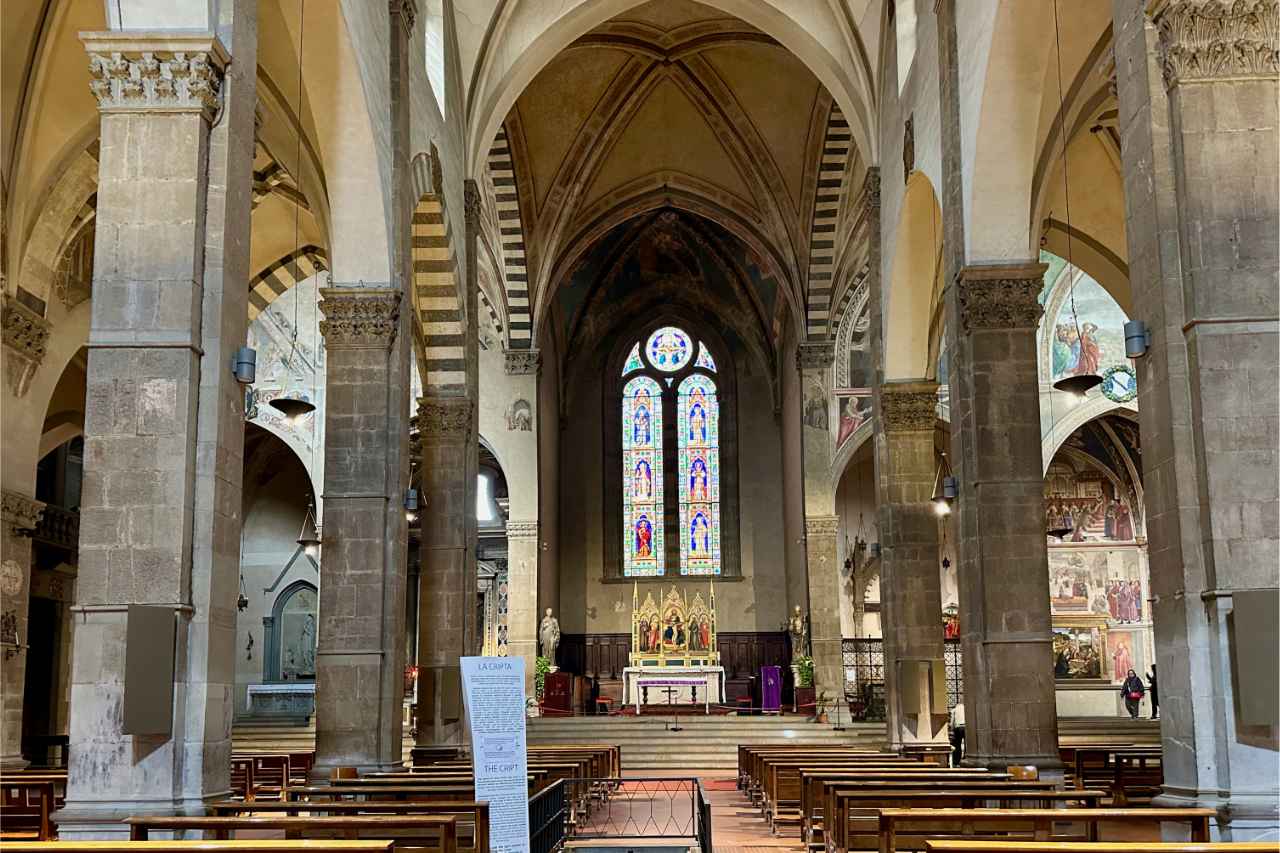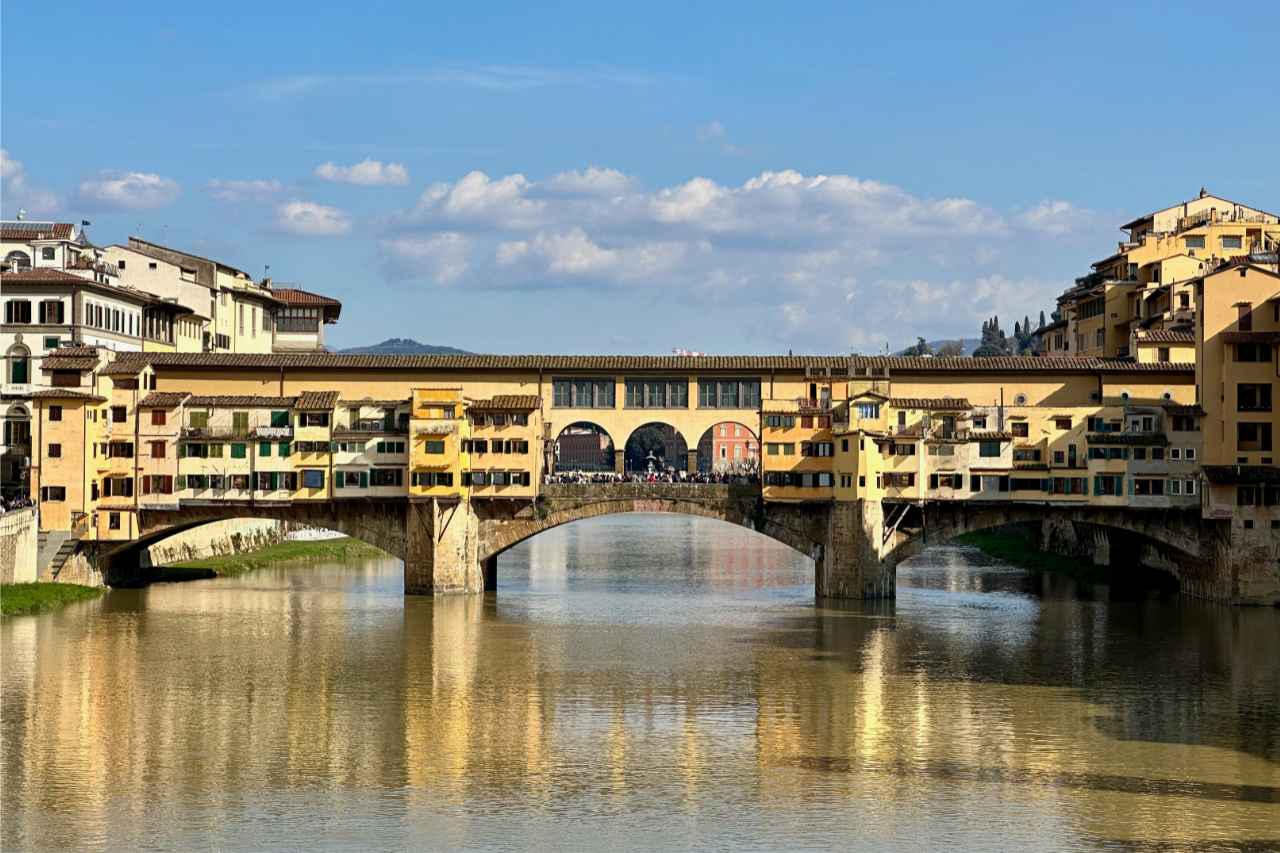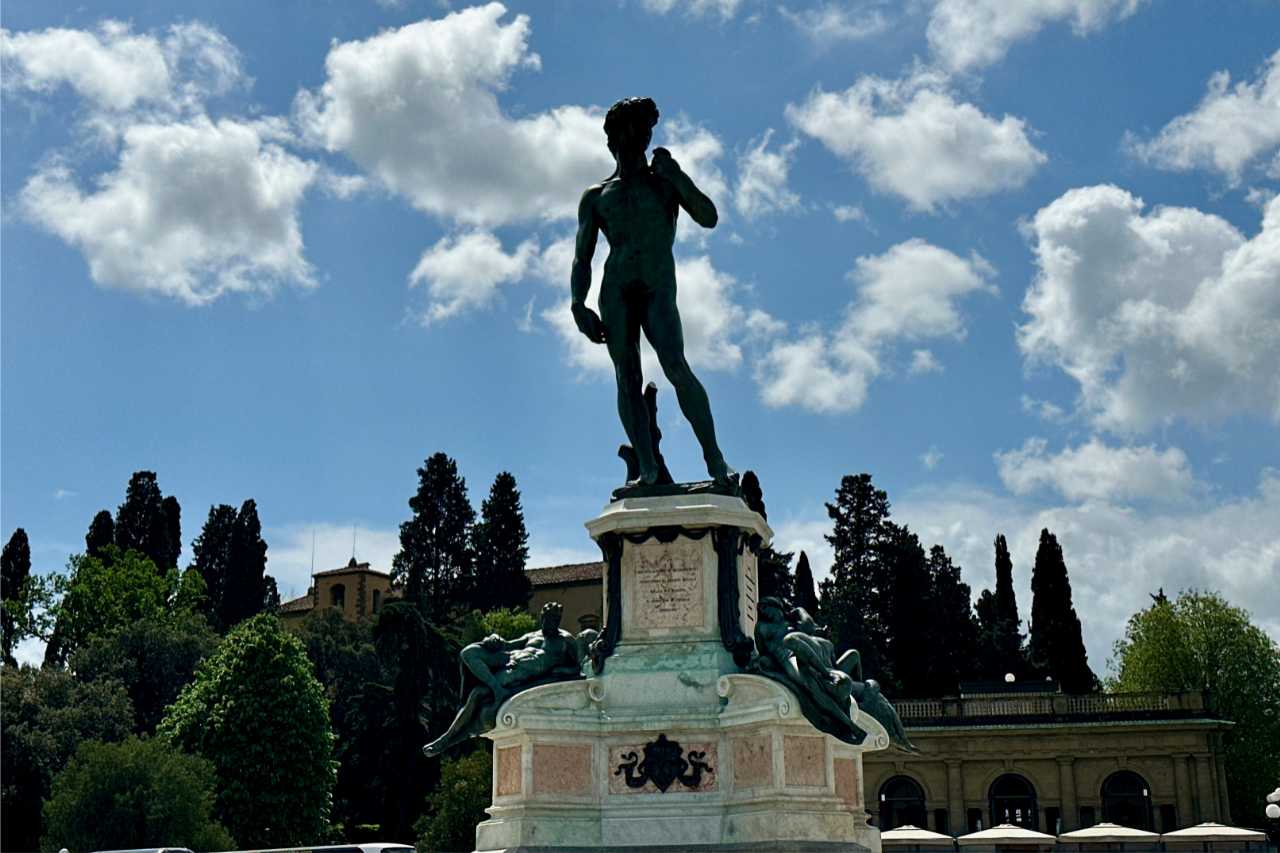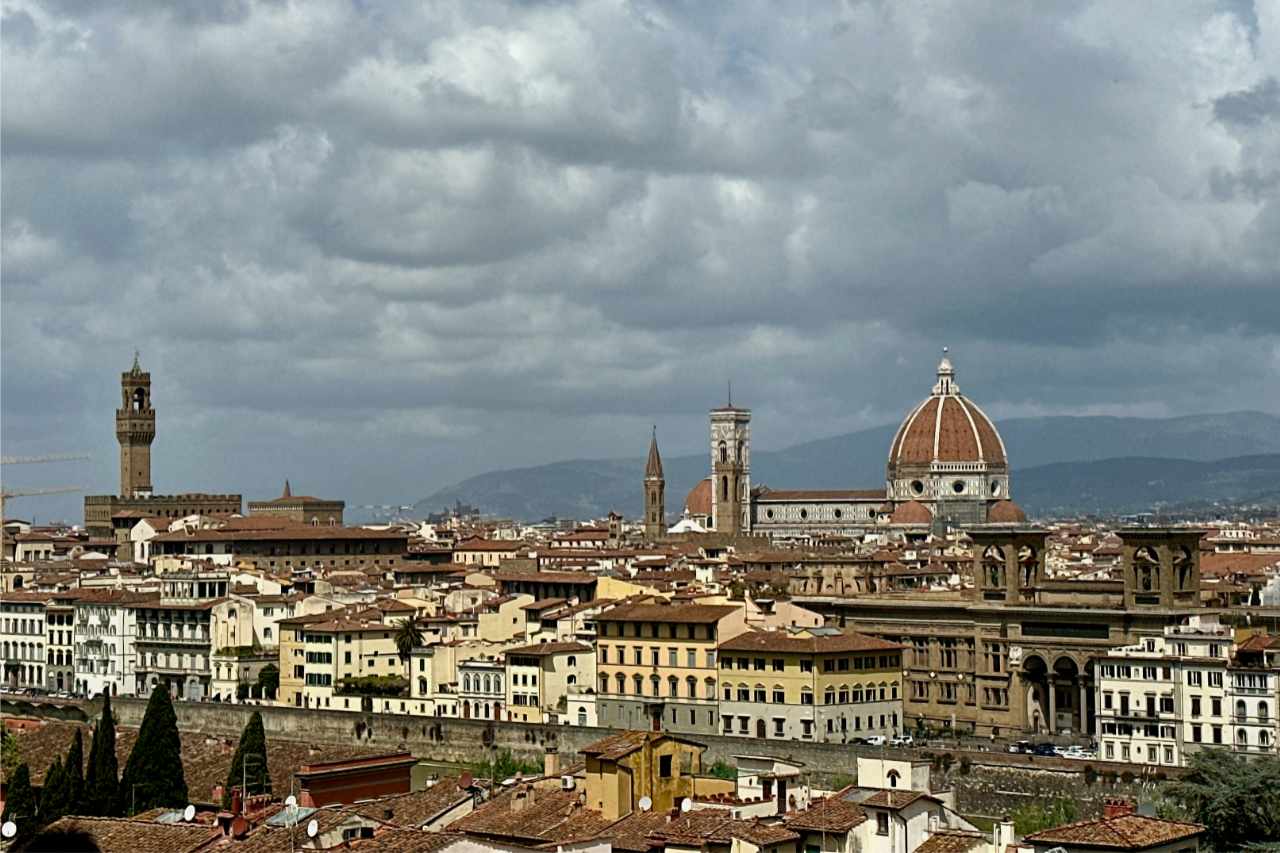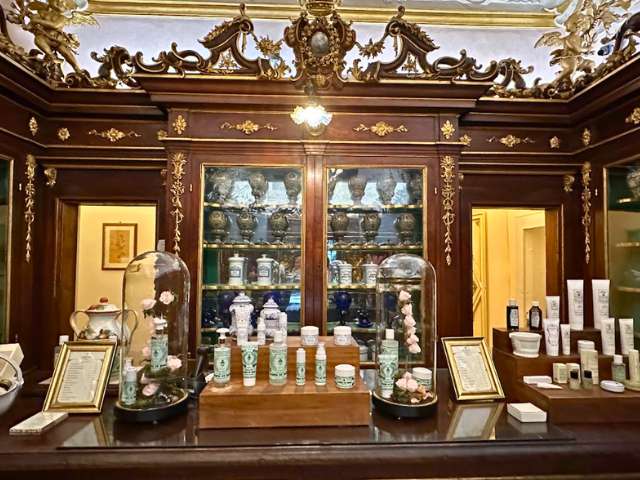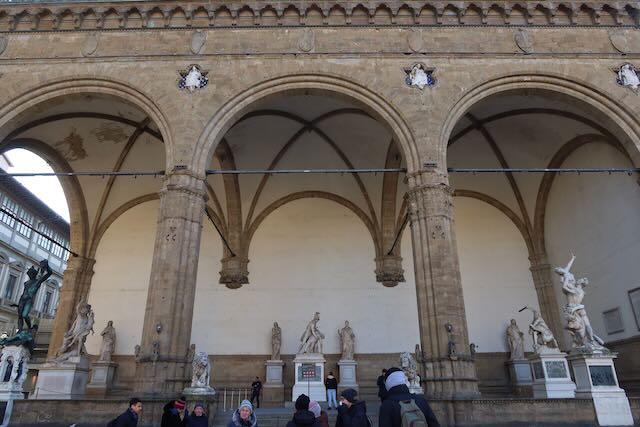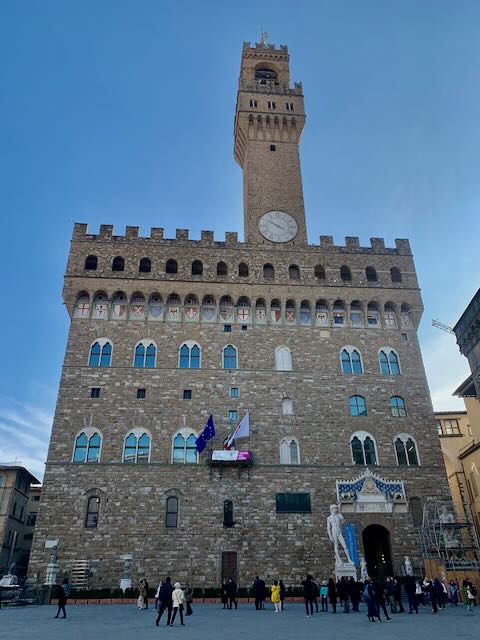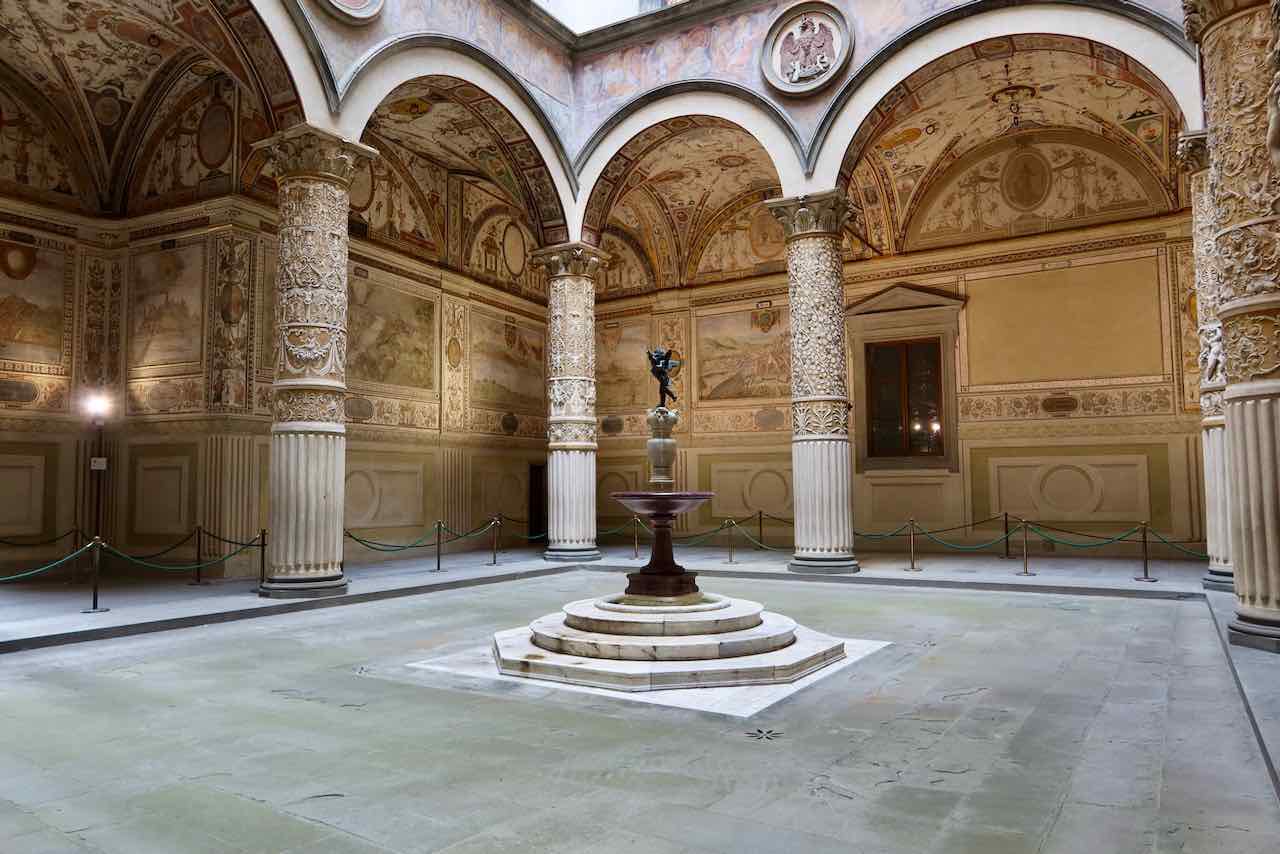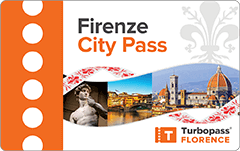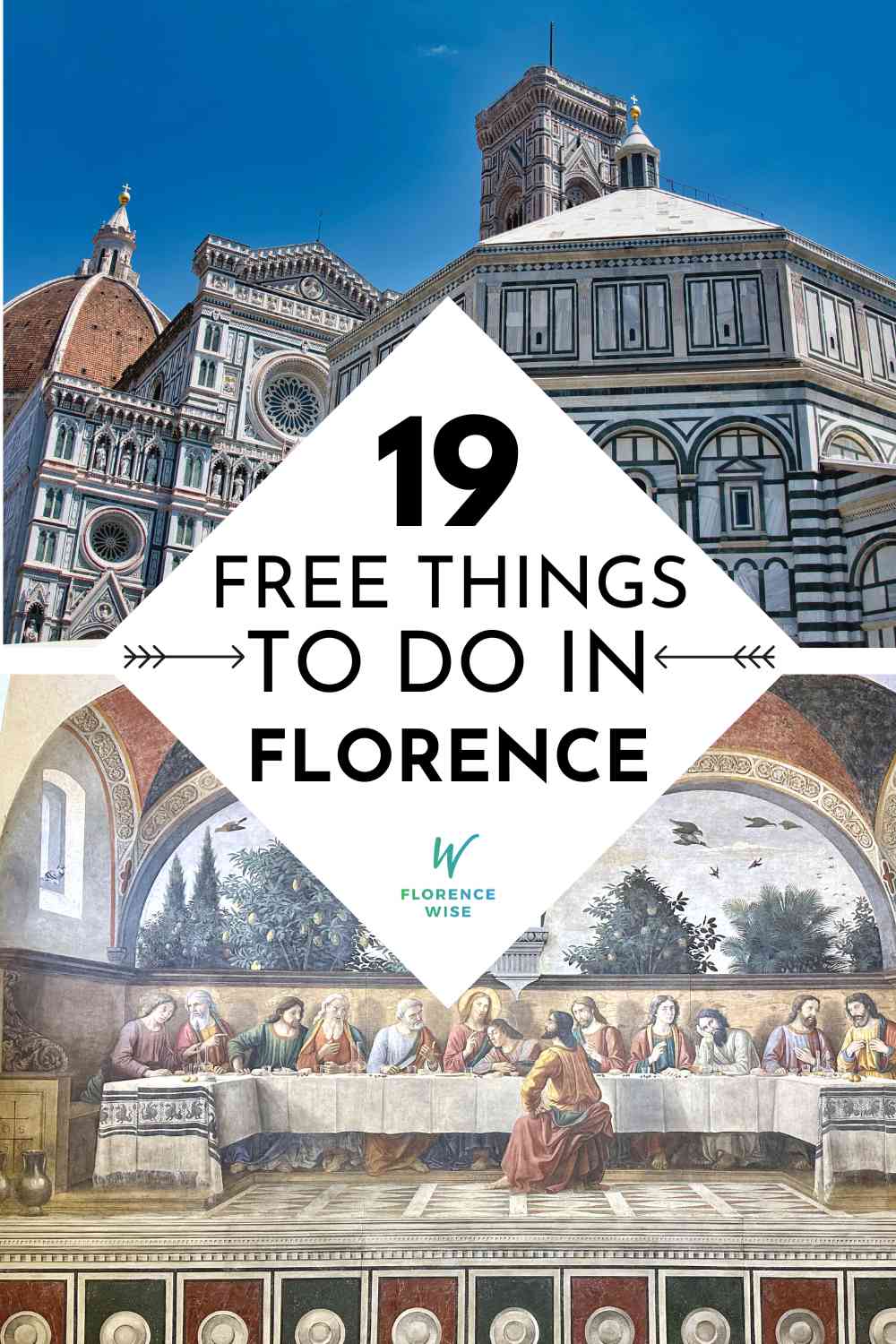- Sign up & get a FREE ebook Subscribe Today!
- Florencewise Home Page
- What to do in florence
- Free Things to do in Florence
19 Free Things To Do In Florence, Italy
Looking for free things to do in Florence?
Besides the obvious "walking around and soaking up the atmosphere", Florence offers a wealth of stunning sites that are free to visit any time.
From churches to gardens to courtyards, here are some of the best things you can do in Florence without spending one cent!
Free things to do in Florence - stretch your budget!
Of course you can visit some of Florence's beautiful piazzas such as Piazza della Signoria and Piazza della Reppublica.
 Piazza della Repubblica is just one of Florence's many beautiful piazzas you can enjoy as you walk around its center.
Piazza della Repubblica is just one of Florence's many beautiful piazzas you can enjoy as you walk around its center.And there are times when you can enter major sites for free, like the first Sunday of the month when state museums, the Uffizi Gallery, Boboli gardens and more have free entry.
 Once a month you can see the stunning art on display in the Uffizi Gallery like this Adoration of the Magi by Leonardo da Vinci for free, but what if you're not in Florence on that day?
Once a month you can see the stunning art on display in the Uffizi Gallery like this Adoration of the Magi by Leonardo da Vinci for free, but what if you're not in Florence on that day?But you have plenty of choices for actual sites in Florence, including some of Florence's most iconic churches, with free access as standard all the time!
You'll also be able to enjoy some free art, architecture, and green spaces.
(I'm not including markets in this list, as it goes without saying you can visit a market for free, although you may wind up spending money there!)
Whether you are on a budget or just want to explore all that Florence has to offer, don't miss these special places!
- Cathedral of Santa Maria del Fiore, also known as the Duomo
- Santo Spirito
- Saint Salvatore of Ognissanti
- San Miniato al Monte
- The Last Supper by Andrea del Castagno in Sant'Appollonia
- The Last Supper by Domenico Ghirlandaio
- Votive Cloister in Santissima Annunziata
- Chiostro dello Scalzo
- The Life of Saint Francis fresco by Ghirlandaio in Santa Trinita
- Rose Garden
- Stibbert Museum Garden
- Cascine Park
- Ponte Vecchio
- Piazzale Michelangelo
- Santa Maria Novella Pharmacy
- Loggia dei Lanzi and Piazza della Signoria
- Entrance of Palazzo Vecchio
- Chapel of Buonomini di San Martino
- Casa Museo Rodolfo Siviero
Click here to see a map of all these sites on Google Maps.
It will open in a new window.
Take a look at these pages to find out how to make the most of your time in Florence:
Duomo, Cathedral of Santa Maria del Fiore
Florence Cathedral - 'Cathedral of Saint Mary of the Flower' - features the largest brick dome ever constructed.
Along with the baptistery and the bell tower in Piazza del Duomo, it's part of a UNESCO World Heritage Site covering all of Florence's historic center.
One of Italy's largest cathedrals, the Duomo remains a tourist favorite thanks to the spectacular marble on the exterior, which looks magnificent (especially when lit up at night!)
While the outside is really impressive, I find the cavernous interior a little underwhelming, just because it's relatively simple inside.
The frescoes on the inside of the cupola are astounding but not that easy to see from ground-floor level.
 One of the most beautiful things about the church of Santa Maria del Fiore, the Duomo of Florence, is the stunning Last Judgement fresco on the inside of the dome.
One of the most beautiful things about the church of Santa Maria del Fiore, the Duomo of Florence, is the stunning Last Judgement fresco on the inside of the dome.Many fine artworks have been added over the years, including a large clock decorated by the celebrated artist Paolo Uccello, but for such a prominent landmark, you will see the most impressive elements from outside in the Piazza del Duomo.
If you have time, don't miss the underground area of Santa Reparata, or the climb all the way up to the dome (neither of these are free however.)
Opening hours and location:
- Monday-Saturday 10:15 - 15:45 | Sunday CLOSED
- Piazza del Duomo
Santo Spirito
Completed in the late 1400's, the church of Santo Spirito is in the Oltrarno quarter of Florence and an excellent example of Renaissance architecture.
Unlike the Duomo, it does not look anywhere near as impressive on the outside.
But head inside and you'll be greeted with a breathtaking masterpiece designed by genius architect Filippo Brunelleschi (who also designed the dome of the Duomo, above.)
The 38 side chapels contain several important pieces of artwork, with altarpieces in the transept chapel by Filippino Lippi being particularly stunning!
One of the biggest draws for me is the famous Crucifix of Michelangelo, which hangs in the church's sacristy.
This wooden crucifix was likely completed in the 1490's but was lost for hundreds of years before being rediscovered in 1962.
Michelangelo's crucifix
I should point out that many art historians contend that this is not the work of Michelangelo so you will have to decide if you want to see it.
There is a small fee to view the crucifix but for me, it's well worth it, whether it was made by Michelangelo or not.
Once you've explored inside, head back out to the Piazza Santa Spirito and turn around to admire the ornate bell tower.
Opening hours and location:
- Monday-Tuesday: 10:00 - 13:00, 15:00 - 18:00 | Wednesday CLOSED | Thursday - Saturday: 10:00 - 13:00, 15:00 - 18:00 | Sunday: 11:30 - 13: 30, 15:00 - 18:00
- Piazza Santo Spirito, 30
Oltrarno is a fun place to spend some time after your visit.
Take a seat in the piazza, order a coffee and people watch before taking a walk back to the city center.
It's the perfect place to see Florentine life in action!
Saint Salvatore of Ognissanti
 The basilica of Ognissanti is a very special free church you can visit in Florence. There is a lot to see inside!
The basilica of Ognissanti is a very special free church you can visit in Florence. There is a lot to see inside!Saint Salvatore of Ognissanti - 'Church of All Saints'- is a stunning basilica - one of very few examples of truly Baroque architecture in Florence (unlike Rome which is chock-a-block with Baroque churches!)
The ornate facade leads to a magnificent interior that includes some important artworks.
One of the main reasons for visiting is to see the burial place of two important historical figures.
(There is another reason for visiting, another free thing to see, further down this page.)
 This beautiful fresco by Sandro Botticelli of Saint Augustine is reason enough alone for me to visit the Basilica of Ognissanti.
This beautiful fresco by Sandro Botticelli of Saint Augustine is reason enough alone for me to visit the Basilica of Ognissanti.One of my favorite pieces to see is an ethereal painting by Sandro Botticelli, depicting Saint Augustine in his study.
I would happily pay to see this but it's free!
Botticelli himself is buried here, as is the youngest sister of Napoleon, Carolina Bonaparte, who was queen of Naples.
There are actually many more beautiful and important things to see in this church, but one you can't miss is the crucifix by Giotto.
It's just to the left of the apse.
Make sure to stop by the Vespucci side chapel, a Florentine family whose most famous member was Amerigo Vespucci, whose name was used to name America, to see some stunning frescoes by Domenico Ghirlandaio.
Opening hours and location:
- October 1 - March 31: Tuesday CLOSED | Monday, Wednesday - Sunday: 09:00 - 13:00 | 15:00 - 19:30
- April 1 - September 30: Tuesday CLOSED | Monday, Wednesday - Sunday: 09:00 - 13:00 | 15:00 - 20:00
- Borgo Ognissanti, 42
San Miniato al Monte
The San Miniato al Monte basilica sits on one of Florence's highest points, just up from Piazzale Michelangelo with its amazing views, thought to be one of the most beautiful examples of Romanesque architecture in Tuscany.
The spectacular interior of the church is well worth the climb up the hill, with the panoramic view of Florence an added bonus.
You can take the bus or a taxi if you prefer!
Construction of the church began in 1013, before a monastery was also built next door which was originally run by a Benedictine order.
Today, the working monastery is still home to Olivetan monks, who have been in residence since 1373 - yes, the monastery has been in use for over a millennium!
While free to enter, the shop next door run by the monks sells homemade liqueurs, herbal teas, and honey so you may well find yourself spending some money on these delicious treats.
The adjoining Monumental Cemetery is also really interesting, with a number of historical figures buried here, including the famous painter Pietro Annigoni, Carlo Collodi (who created Pinocchio), and the great filmmaker Franco Zeffirelli.
Both the basilica and cemetery are free.
Opening hours and location:
- Monday - Saturday: 9:30 - 13:00, 15:00 - 19:00 | Sunday: 8:15 - 13:00, 15:00 - 19:00
- Via delle Porte Sante, 34
The Last Supper by Andrea del Castagno in Sant'Appollonia
There are many artistic interpretations of The Last Supper, called "cenacoli" in Italian.
This beautiful example by Andrea del Castagno was not known to the public until the 1860s.
 This "cenacolo", or Last Supper fresco by Andrea del Castagno is one of my favorite free things to see in Florence.
This "cenacolo", or Last Supper fresco by Andrea del Castagno is one of my favorite free things to see in Florence.The fresco was created in the 15th century along the wall of the refectory in the convent of Sant'Apollonia, so for hundreds of years it was only the nuns who lived there who were able to see it.
After the convent closed in the 1800's, the incredible work was finally available to the public, and it is absolutely worth the detour to see it.
This part of the convent is now a museum, but has free entry!
One of my favorite things about Sant'Appollonia is the display of sinopie, which are preparatory sketches for the works you see there, giving a fascinating insight into the process these artists had to go through to create the final product.
Opening hours and location:
- Monday - Sunday: 8.15 - 13.50.
- CLOSED 1st, 3rd, 5th Saturday and Sunday each month. January 1st, December 25th, from 5 to 16 June.
- Via Ventisette Aprile, 1
The Last Supper by Domenico Ghirlandaio
Located in the convent of the Ognissanti in central Florence, this example is one of three depictions of The Last Supper, "cenacolo" in Italian, painted by the great Renaissance artist Domenico Ghirlandaio on display in Florence.
If you're an art lover, this is one of the free things you have to see, both for the quality of the painting and the impact on art history!
 To see the Last Supper fresco by Ghirlandaio, you'll enter this Renaissance cloister that is part of the church of Ognissanti.
To see the Last Supper fresco by Ghirlandaio, you'll enter this Renaissance cloister that is part of the church of Ognissanti.Ghirlandaio was a very famous artist in his time.
He worked on the original artwork in the Sistine Chapel - his pupil Michelangelo was asked to paint its ceiling several decades later!
Leonardo da Vinci was likely familiar with Ghirlandaio's version of The Last Supper, and some art historians believe he may have been influenced by it when creating his own masterpiece.
Opening hours and location:
- October 1 - March 31: Tuesday CLOSED | Monday, Wednesday - Sunday: 09:00 - 13:00 | 15:00 - 19:30
- April 1 - September 30: Tuesday CLOSED | Monday, Wednesday - Sunday: 09:00 - 13:00 | 15:00 - 20:00
- Borgo Ognissanti, 42
Votive Cloister in Santissima Annunziata
The Basilica Santissima Annunziata may be a minor basilica in Florence, yet it is famous for the Chiostrino dei Voti or Cloister of the Vows.
A small but elaborate cloister in front of the pretty building facade, it's known for its eight notable artworks, including the Birth of the Virgin by Andrea del Sarto.
The cloister itself is easy to visit as you can walk right in from the square.
The church is harder to visit, masses are held one after the other each morning so it's worth returning later in the afternoon to see if you can go inside.
The piazza in front of the cloister is also impressive, not only because of its size, but also because of the large bronze equestrian statue, which was the last work Giambologna completed.
This is a great free place to visit on your way to or from the Accademia gallery, which is only a few minutes walk away.
Opening hours and location:
- Monday - Friday: 7:30 - 12:30, 16:00 - 18:30 | Saturday - Sunday: 7:30 - 12:30, 16:00 - 18:30, 20:45 - 21:45
- Piazza della SS. Annunziata
Chiostro dello Scalzo
Chiostro dello Scalzo was originally the entrance hall to a chapel, but now only the cloister itself remains.
This is one of my favorite free things to do in Florence, and I always try to pop inside when I visit the nearby Accademia gallery.
I've never seen more than a handful of people inside, and sometimes, we are completely alone here.
The light coming through the glass ceiling gives the space a meditative, peaceful feeling and I always find myself slowing down when I walk in here.
Going inside the unassuming door you will be met with an incredible series of frescoes by Andrea del Sarto, depicting the life of St John the Baptist.
The twelve scenes were done in a style of painting known as 'grisaille,' which is a method using tones of grey only, which results in a beautiful and mysterious atmosphere with a mythical undertone.
The del Sarto fresco cycle is undoubtedly worth a visit, especially if you are in the San Marco neighborhood and/or visiting the wonderful museum of San Marco right nearby.
Opening hours and location:
- Monday - Sunday: 08:15 - 14:00
- Via Camillo Cavour, 69
🤙 Roaming in Italy? 📱
Get yourself an Italian eSIM for calls, messages and data when traveling here.
Save on data charges with plans from just 19€ from Holafly - our recommended eSIM provider - click here to find out more.
The Life of Saint Francis fresco by Ghirlandaio in Santa Trinita
It's easy to walk right past the basilica of Santa Trinita and not go inside, but you should not miss the church if you can help it!
Found in the heart of the city, close to the Arno river and the Ponte Santa Trinita bridge, the basilica has been witness to centuries of Florentine history, being built originally in the 13th century.
The church's Sassetti chapel houses an undisputed masterpiece, a stunning series of six frescoes by the great Domenico Ghirlandaio showing scenes from the life of Saint Francis.
Occupying three walls of the Sassetti Chapel, the series is known as the 'Stories of St. Francis' and shows his life in glorious color and astonishing detail.
 This stunning fresco by Domenico Ghirlandaio is part of a larger fresco in the Sassetti chapel in the church of Santa Trinita.
This stunning fresco by Domenico Ghirlandaio is part of a larger fresco in the Sassetti chapel in the church of Santa Trinita.Of particular interest is 'The Confirmation of the Rule' which depicts various people who were very important in the 15th century, including members of the Medici family along with current and future popes.
These are considered to be extremely accurate portraits, as Ghirlandaio painted them from life, rather than dramatizing them as other artists of the time would do.
This particular fresco is widely considered to be one of Ghirlandaio's greatest works, and the church is simply an amazing place so definitely add this to your Florence Italy itinerary!
Opening hours and location:
- Monday - Sunday: 07:00 - 12:00, 16:00 - 19:00
- Piazza di Santa Trinita
Rose Garden
Given Florence is one of the most impressive cities in the world when it comes to art and architecture, it's no surprise that most free attractions in Florence are based on that, but it's not all churches and paintings!
The Giardino delle Rose is a magnificent garden just below Piazzale Michelangelo that offers stunning views across Florence.
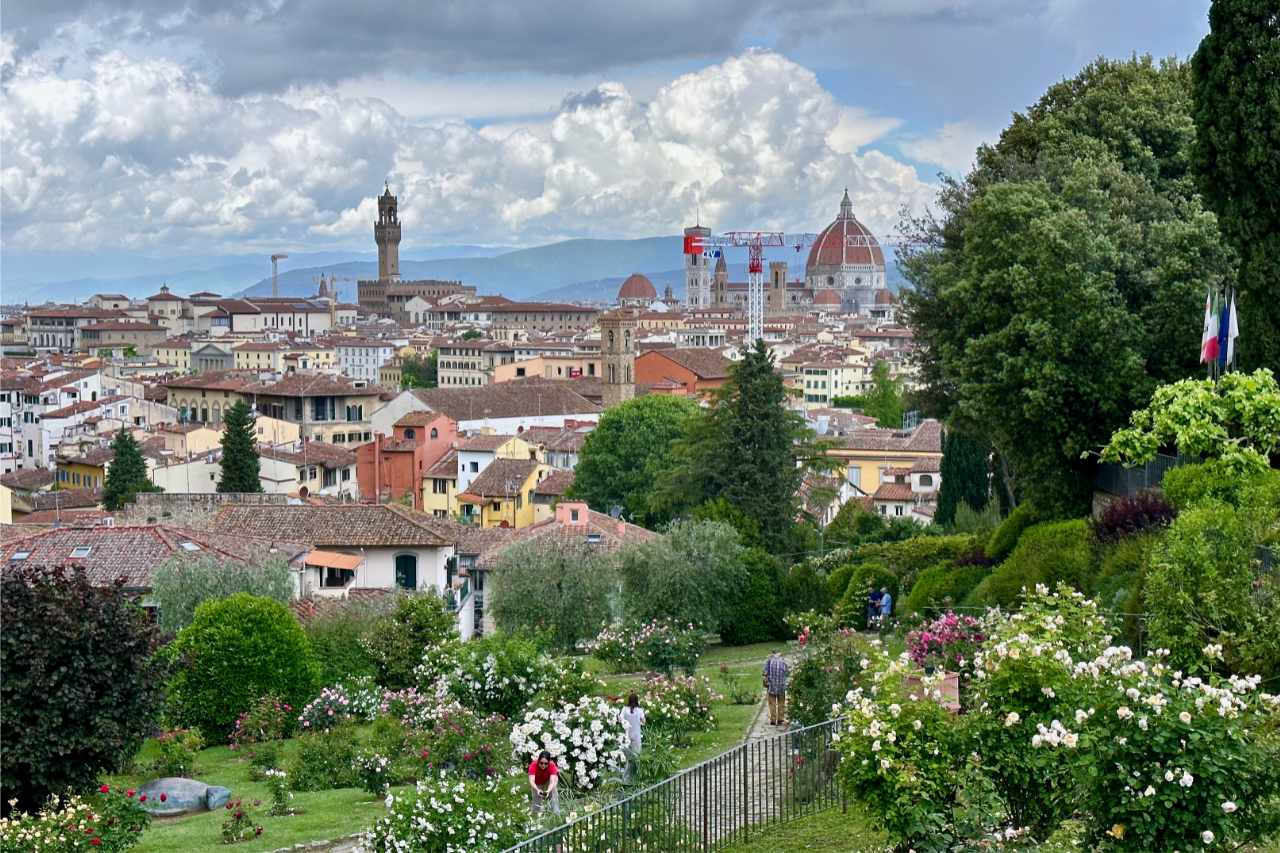 The Rose Garden just below Piazzale Michelangelo offers beautiful panoramic views of the city and in spring and fall, when the roses are in full bloom, it's a wonderful place to visit.
The Rose Garden just below Piazzale Michelangelo offers beautiful panoramic views of the city and in spring and fall, when the roses are in full bloom, it's a wonderful place to visit.The garden was commissioned in 1865 when the city became the capital of Italy (which was later switched to Rome) and first opened to the public in 1895.
Originally only open in May and June when the spectacular roses were in bloom, other plants were added and now it is open all year round, although it's still at its best in spring.
To me this is one of the best free things to do in Florence Italy, and perfect for those on a travel budget!
Opening hours and location:
- Monday - Saturday: 09:00 - 20:00, Sunday: 10:00 - 20:00
- Viale Giuseppe Poggi, 2
No matter when you visit Florence, here are four things never to leave at home:
Disclosure : If you make a purchase through a link on this page, I may receive a small commission - at no extra cost to you. Thank you for supporting my site!
Stibbert Museum Garden
The Stibbert Museum houses an eclectic collection put together in the 19th century by Frederick Stibbert.
Born in Florence, with an English mother and Italian father, he inherited a huge fortune when he was 21 and spent his life (and the money!) creating his collection and the unique gardens.
On his death, he left his home and collection to the city of Florence for it to be displayed to the public.
Stibbert's garden is fascinating, filled with symbolic layouts pointing to mysterious and Masonic imagery, grottos and cascades, statues and fake ruins, and even a mock Egyptian temple!
A great place to visit with kids, it's open all year round except Thursdays and major holidays.
Opening hours and location:
- Monday - Wednesday: 08:00 - 19:00 | Thursday CLOSED | Friday - Sunday: 08:00 - 19:00
- Via Federico Stibbert, 26
Part of traveling on a budget is getting a great deal on accommodation.
Staying in apartments is generally cheaper than staying in hotels, with cooking and washing facilities in house, and Florence has some excellent self-catering accommodation options to choose from!
Cascine Park
 Cascine park is the perfect place to escape the busy streets of Florence! Photo credit: Paolo Costantini
Cascine park is the perfect place to escape the busy streets of Florence! Photo credit: Paolo CostantiniOriginally a large estate of the Medici family, used for farming and hunting, the Cascine Park is now the largest public park in Florence.
Running along the north bank of the River Arno, the many meadows and wooded areas are delightful to explore and a great place to cool off in the summer, especially if you're traveling with kids.
Florence's largest park also has many sporting venues, including a swimming pool, tennis courts, football fields, and a velodrome, and a visitor center was added in 2013.
The park is well-maintained and under constant improvement, easily reached on tram Line T1 from the city.
Opening hours and location:
- Open daily, 24 hours
- Piazzale delle Cascine
Ponte Vecchio
One of the most famous landmarks in Florence is the Ponte Vecchio.
A bridge was erected here at the river Arno's narrowest point in Roman times, and the old bridge structure we see today dates mainly from the 14th century when it was rebuilt.
As well as being of great historical importance, the Ponte Vecchio is famous for the shops that line its length.
Originally these shops would have been selling the goods of mainly tanners, farmers, and especially butchers, but today, the shops cater to the vast numbers of tourists walking over the bridge, selling leather goods, souvenirs, art and jewelry.
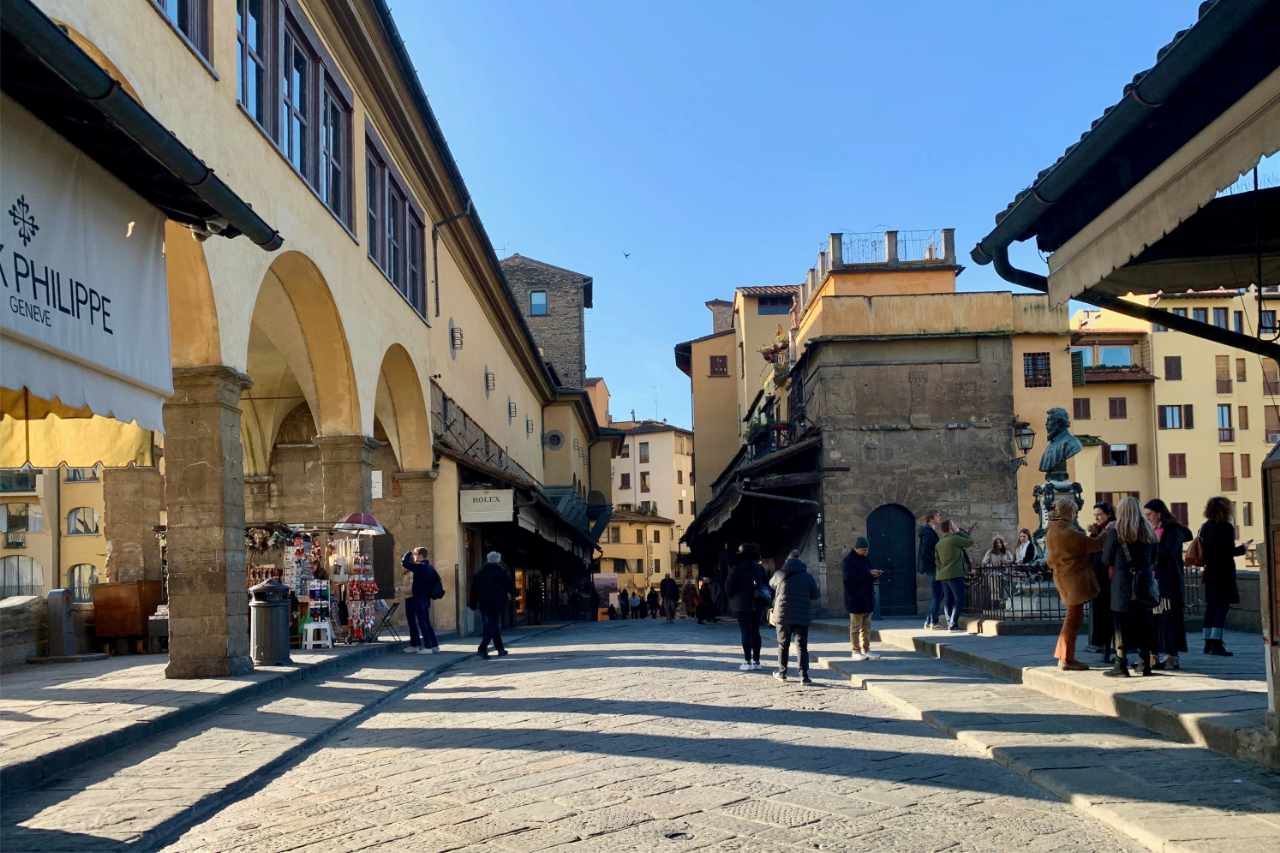 Ponte Vecchio is a delightful place to stroll and shop, especially when it's not crowded like in the early morning.
Ponte Vecchio is a delightful place to stroll and shop, especially when it's not crowded like in the early morning.Going across the top of the bridge, you can see the Vasari Corridor, which was what the Medici family used to cross the river without having to mix with the people below.
As of 2025 you can now add on access to the corridor to your Uffizi Gallery tickets.
Opening hours and location:
- Open daily, 24 hours
- Ponte Vecchio
Piazzale Michelangelo
Named after one of Florence's most celebrated sons, the great High Renaissance painter, poet, sculptor and architect Michelangelo, Piazzale Michelangelo is a square high up on the hill overlooking this beautiful city.
Designed by Giuseppe Poggi in 1869 when Florence was the capital of Italy and undergoing considerable renovation, the central sculpture is a bronze cast of Michelangelo's David, one of the most famous sculptures in the world.
The original is now in the Galleria dell'Accademia in Florence and should be viewed by anyone visiting the city.
The square is perfect for the best views of Florence, and both locals and tourists love coming here at sunset, with good reason!
You should not visit Florence and miss out on Piazzale Michelangelo.
Opening hours and location:
- Open daily, 24 hours
- Piazzale Michelangelo
Santa Maria Novella Pharmacy
A genuine curiosity and place of great historical importance is the pharmacy of Santa Maria Novella.
Across the road from the beautiful church of Santa Maria Novella, the Dominican monks who lived in this church complex grew herbs and sold various herbal remedies and perfumes to the locals.
Over the centuries the monks have continued to sell their products, giving their store the reputation of the oldest pharmacy in the world.
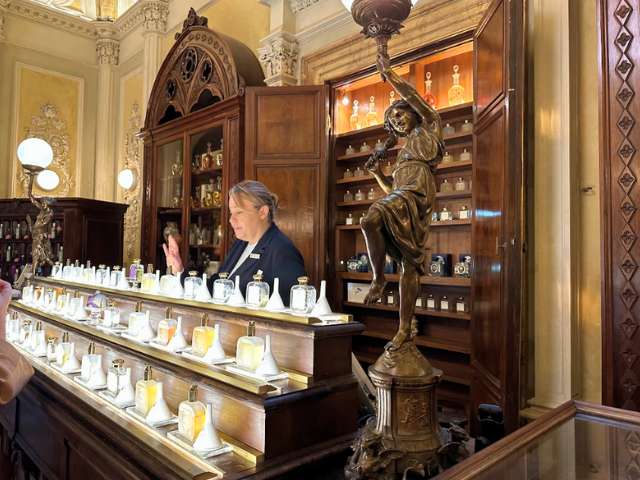 Listening to the expert staff talk about the different fragrances in their collection is so interesting!
Listening to the expert staff talk about the different fragrances in their collection is so interesting!Today you can visit the store and browse the high quality, artisan products on offer from the ancient pharmacy (which have been refined for modern requirements!) as well as a small museum featuring fascinating exhibits telling the story of the World's Oldest Pharmacy.
Opening hours and location:
- Monday - Sunday: 9:30 - 20:30
- Via della Scala, 16
Loggia dei Lanzi and Piazza della Signoria
Located on the beautiful Piazza della Signoria, the Loggia dei Lanzi is an open-air gallery featuring many wonderful Renaissance sculptures and works of art.
Next to the world-famous Uffizi Gallery, which houses perhaps the world's greatest collection of Renaissance art, the spectacular sculptures on display in the loggia include the magnificent bronze 'Perseus with the Head of Medusa' by the great Benvenuto Cellini, which took almost 10 years to complete.
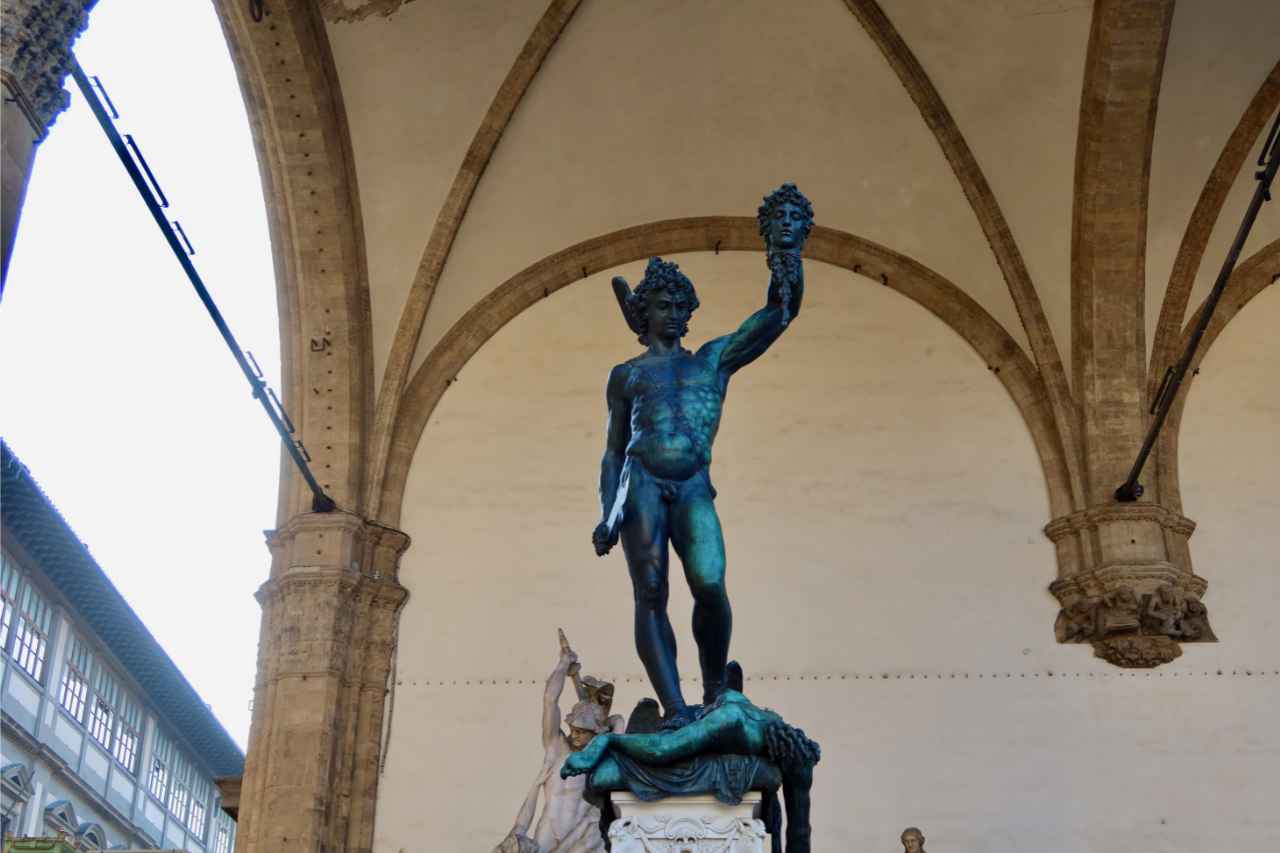 Cellini's famous bronze statue of Perseus holding the head of Medusa can be found in the Loggia dei Lanzi in Piazza della Signoria.
Cellini's famous bronze statue of Perseus holding the head of Medusa can be found in the Loggia dei Lanzi in Piazza della Signoria.And don't miss the rest of the impressive sculptures there.
You can walk up onto the loggia and get up close to them.
Opening hours and location:
- Open daily, 24 hours
- Piazza della Signoria
Entrance of Palazzo Vecchio
The famous Palazzo Vecchio is the magnificent town hall of Florence and is particularly well-known for its wonderful entrance.
The impressive marble frontispiece features the Monogram of Christ and an inscription in Latin that translates as 'King of Kings and Lord of Lords.'
Michelangelo's David originally stood at the entrance until 1873, when it was moved to the Accademia Gallery, but a replica stands to one side of the doorway today.
You can pop inside Palazzo Vecchio for free to see the ground floor courtyard as well if you don't want to pay to go inside the museum, but it contains a wealth of important artwork and sculptures so for me it's worth visiting, and even climbing the tower, for a fee.
But if you don't have time, even just the entrance is well worth a peek!
Opening hours and location:
- Open daily, 24 hours
- Palazzo Vecchio: Monday - Wednesday: 09:00 - 22:00 | Thursday: 09:00 - 14:00 | Friday - Sunday: 09:00 - 22:00
- Piazza della Signoria
Chapel of Buonomini di San Martino
This is one of my favorite free things to do in Florence because it really feels like a well-kept secret.
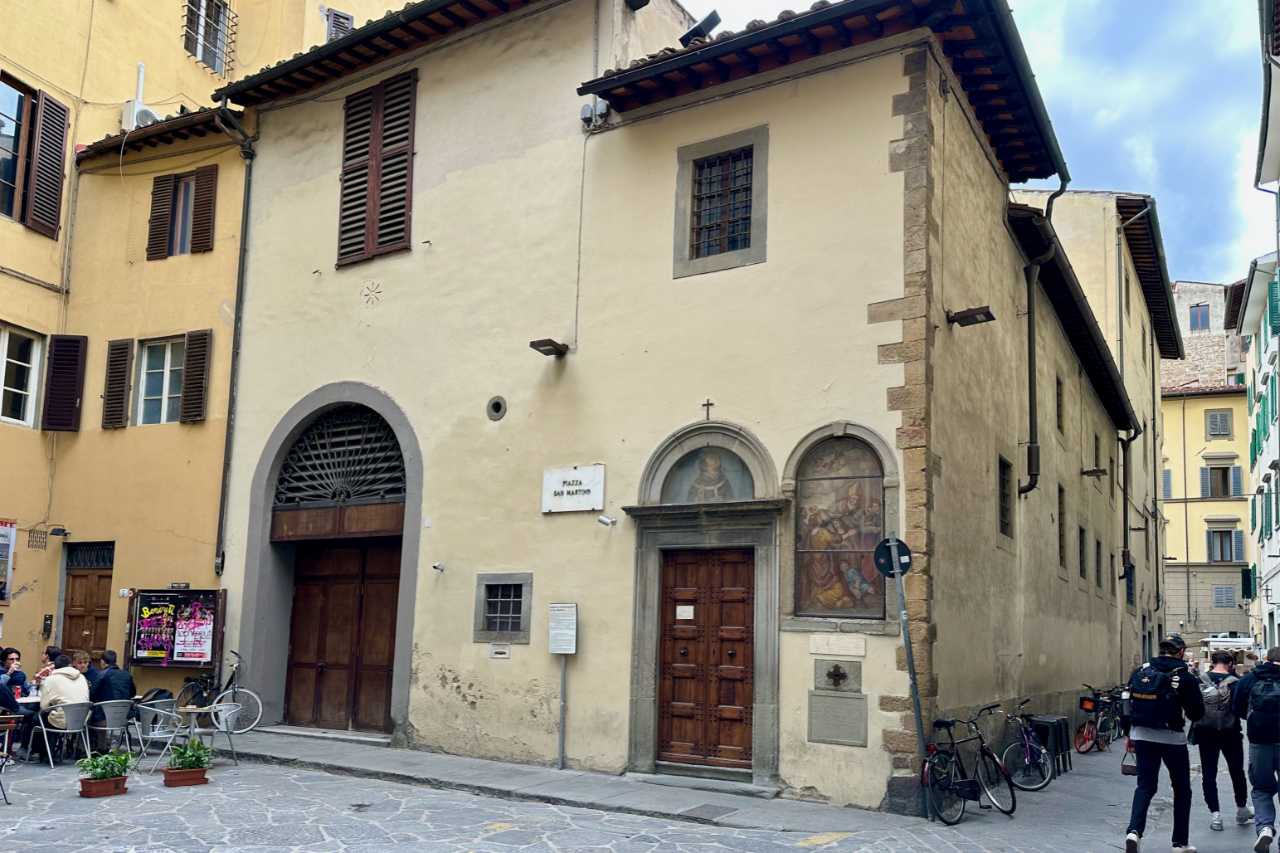 The exterior of the Oratorio di Buonomini di San Martino is so non-descript, you could easily walk right past it.
The exterior of the Oratorio di Buonomini di San Martino is so non-descript, you could easily walk right past it.Located in the small Piazza San Martino, the Buonomini di San Martino chapel dates back as far as 986.
The Buonomini are a lay order of Christian brothers known as 'The Procurators of the Shamed Poor of Florence' who are famous even today for their charitable work, although they keep secret who they help.
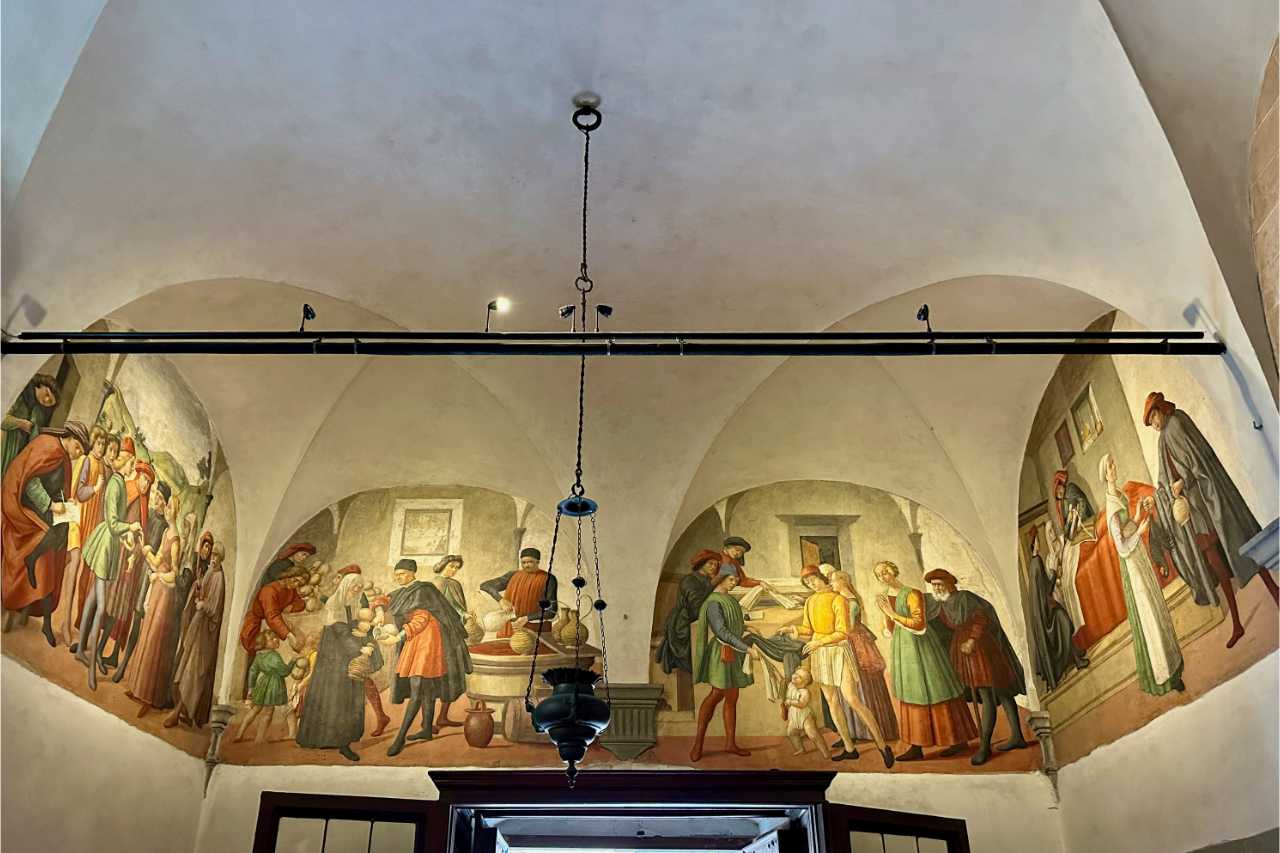 It's worth popping in to see the beautiful frescoes adorning the walls of this small oratory in Florence's center.
It's worth popping in to see the beautiful frescoes adorning the walls of this small oratory in Florence's center.There are ten lunettes going around the tops of the walls.
They depict scenes in the life of Saint Martin and other scenes from life in Florence in the 15th century.
Because the frescoes show what life was really like in everyday Florence in the Renaissance, they are especially important as well as interesting to study in detail.
The bright vivid colors are even more beautiful after recent restoration work.
Opening hours and location:
- Monday - Thursday: 10:30 - 12:30, 14:30 - 17:00 | Friday - Saturday: 10:30 - 12:30 | Sunday CLOSED
- Piazza S. Martino
Casa Museo Rodolfo Siviero
This fascinating museum in Florence is a testament to the life and work of Rodolfo Siviero, often nicknamed the '007 of Art.'
He dedicated his work as a Minister of Foreign Affairs in the 1950's to recovering hundreds of important works of art taken from Italy during World War II by the Germans.
On his death in 1983, he left his house and all belongings to the city with the proviso that it became a museum open to the public.
The artworks, including many from artists Siviero knew personally, such as Pietro Annigoni, are from his collection.
All the works recovered by him and his team were returned to their owners or museums, so getting to see a fantastic collection and learn about a man who worked in military intelligence during the war and dedicated his life to art makes for a truly enjoyable experience!
Opening hours and location:
- Monday: 10:00 - 13:00 | Tuesday - Friday CLOSED | Saturday: 10:00 - 18:00 | Sunday: 10:00 - 13:00
- Lungarno Serristori, 1/3
Florencewise's Top Travel Resources
Ready to book your trip to Florence? Take a look at these helpful links to companies we use and trust:
- Keep your travel spending simple with the Wise card, which removes all the worry about exchange rates and high transaction fees all over the world
- Search for and book your perfect accommodation
- Our complete guide to what to pack for Florence
- The number one travel accessory, a multi-point travel adapter and voltage converter
- Browse a huge range of tours in Florence and beyond
- Experience unique tours and special access to Florence's most popular sights
- Protect yourself with comprehensive travel insurance
Within this post there are some affiliate links for products and services. For more details about our affiliate policy click here.
Receive the latest Florence news, travel tips, insights and more!
Simply sign-up today for our free newsletter:
We are committed to respecting your data. Click for our Privacy Policy.
Comments? Questions? Suggestions?
Please come over to the private Facebook group and join in the conversation.
You will often find me there, happy to answer your questions / comments!
You will also meet other Florence lovers and experts, too.
What are you waiting for?

